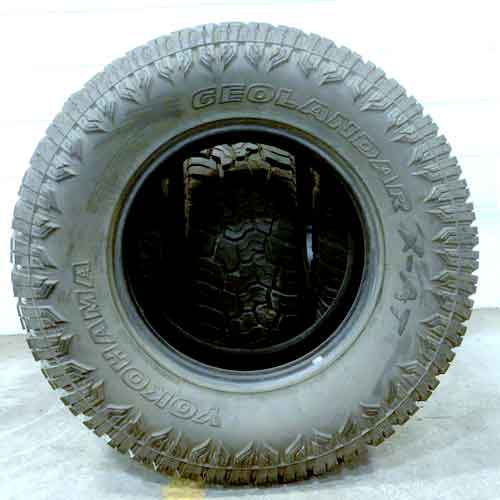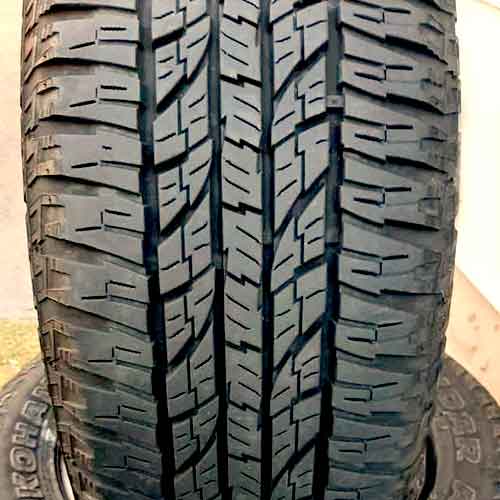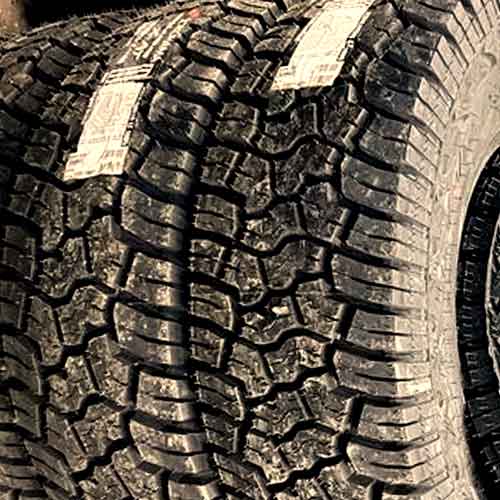Both variants of the Yokohama Geolandar, the X-AT and the A/T, are although coming in all-terrain category, the X-A/T is more aggressive, that’s why they added the X in its name, which abbreviates for “Extreme”. Let see what these tires are capable of.

The Yokohama Geolandar X-AT, in my opinion as a tire engineer, yields superior rugged-terrain performance in comparison, with better climbing abilities on rocks, far better self cleaning on mud and dirt and considerable handling on gravely roads. Contrarily, the Yokohama Geolandar G015 AT is more aligned towards pavements and it’s superior in all performance areas there, where it shines the most on wet roads, comfort, highway snow traction, and off-road, its great with sand as well.
Sidewall Construction
The sidewalls of any off-road tire play a significant role in its overall durability, as they are the primary areas of protection (basically, they are not as thick as the middle part of the tread).
Having said that, Yokohama X-AT is a more durable tire as it offers 3 ply polyester carcass with 2 wide steel belts on top, layered with a nylon cap ply.
(The belts and cap ply don’t cover the sidewalls from underneath, only polyester casing does).
In comparison, the Yokohama Geolandar A/T, although offers similar 2 wide steel belts construction and single nylon cap ply, its polyester casing is only folded with 2 ply.
So, you get a 2 ply sidewalls compared to X-A/T with 3 plies.
Tire Sizes
The Yokohama Geolandar AT provides 112 sizes (in 15 to 22 inches, rim diameters).
- Speed Ratings: R, S, T, and H.
- Load Ratings: SL, XL, C, D and E.
- Weight range: 25 to 70 lbs.
- Tread depth range, 12 to 18/32″ (most sizes have 17/32″).
- Warranty: 50k (LT sizes), 60k (non LT).
- Both 3PMSF and M+S Ratings Available.
On the other side, the Yokohama Geolandar X-AT has sizes with same, 15 to 22 inches.
- They have speed ratings available of only Q.
- Load ratings: C to F.
- Weight Range: 40 to 83 lbs.
- Tread depth: 16 to 19/32″.
- Warranty: 45k miles for all sizes.
- Only M+S Rating Available.
Tread Pattern
Starting with Yokohama A/T, G015, this tire is pretty packed up in comparison.

It offers a very on road oriented design, consisting of 5 ribs.
And all these ribs are equipped with in groove notches, where on the middle most, they are placed laterally, and on the surrounding ribs, they cut through the blocks longitudinally.
This way the tire gets to be very biting on wet roads, though with narrower central blocks its dry grip is compromised a little bit.
But they still offer better stability as all these ribs have a continuous design.
All lugs basically sit on a consistent running secondary layer of rubber underneath, and because of this, they are kept in place, during handling and braking.
Moving towards shoulders, the tire although does not make staggered pattern, it still offers sharp biters there with stepped edges.
And towards middle you find deep notches along with similar siping pattern (seen everywhere else).
On the other side, the Yokohama Geolandar X-AT, being a hybrid, promotes open shoulder lugs on sides, with wider tread voids, compared to the middle lugs. Hybrid tires basically have shoulders of mud-terrain tires, whereas their middle tread looks like any aggressive A/T.

The central section of this tire has 2 different lugs geometry. Though, they seem like L and S shaped to me.
All of them are equipped with traction notches and sipes, which change pattern going thick towards corners (and thin in the middle).
The thinner sipes basically help with water removal while thicker help grab snow, enhancing winter traction.
When combined, the four ribs create straight (very easy to picture) lateral grooves connecting the outer, more open voids of the shoulder lugs.
So, these grooves make very self cleaning channels and helping to that, the surrounding shoulder voids have efficient stone/dirt ejectors.
And yes worth reminding, the lugs on shoulders are pretty straight forward, though they don’t have notches, yet, they still carry similar siping with thicker slits on edges that extend along with the sidewall lugs.
Wet Traction
You can’t expect too much from the rugged terrain tires on wet roads, as they show a lot of slippage.
That’s why Yokohama X-AT lacks in comparison.
It although has a flexible structure (good for water removal), it’s limited in total number of sipes.
The Geolandar G015 A/T on the other side, not only has more siping, all sipes have a more effective design, as they have an interlocking pattern that does not go stiff with sudden braking/sharp turns.
Dry Performance
In order to evaluate the dry performance of an all-terrain tire, we need to consider traction, steering, and cornering ability. Let’s talk all these aspects.
Dry Grip
The middle part of the tire’s tread plays a significant role in directional grip, as this is where the whole weight is focused upon, (and where the most friction is generated).
Looking at the two, it’s pretty obvious why Yokohama X-A/T lacks comparatively, the tire has more tread depth to it, and it’s softer compound is more susceptible to instability during braking/acceleration.
That’s why it speed rating is limited to just Q, whereas you get up H on Yokohama AT G015 (its the best speed rating that you can get in A/T tires).
The Geolandar A/T basically offers a very closed up tread, as I explained in the tread section above, so even though it has a softer rubber composition as well, it’s continuous ribs make a firmer contact with the road.
But note that the tire compared to other (less aggressive) A/T options, lacks a little.
Lateral Traction
Tire’s handling is a measure of how well its able to corner, and the shoulders (on the tread) are the primary point of contact with the road during turns.
Because of this, Yokohama Geolandar AT, as it makes a more consistent design towards edges (with continuous rib design) provides better efficacy, as its in contact with the surface at all times.
Conversely, the Yokohama X-AT being a hybrid, having a lot of spacing between lugs is not able to offer as much traction.
Moreover, the tire’s heavier construction (having 3 ply sidewalls) force shoulder lugs to flex more then needed, wasting energy and limiting steering response.
With such heavier weight, it does not offer good enough under and over-steer balance.
Tread Life
When it comes to tread life, the overall pressure on the lugs is also considered alongside rolling resistance.
The Yokohama X A/T already has more rolling resistance, and with it’s heavier weight, getting divided on fewer lugs, its more susceptible to faster wearing, comparatively.
The Geolandar G015 on the other hand, offers more uniform pressure across it’s tread and even with it’s softer composition, its much better in comparison here.
Comfort
Comfort is basically 2 parts, noise and bumps absorption (capability).
Noise is air hitting the tread, and the more open the tread voids are, the more the air freely moves around striking the walls and generating unwanted sound waves.
That’s why Yokohama G016 X A/T produces more noise pollution, though its pitch sequencing does not allow it to get too loud.
Yokohama A/T in comparison, is silent, but it lacks in other area of the comfort.
Although it’s softer composition is pretty malleable, its less tread depth still affects its overall ability to dissolve the imperfections of the road.
The Geolandar X AT on the other hand, with it’s depth reaching up to 19/32″ offers more room for on-road vibrations to settle down.
Winter Capability
To improve their performance in snowy conditions, off road tires may incorporate features such as soft rubber compounds that remain pliable in cold temperatures.
That’s why winter tires are so soft.
Moreover, they also carry notches, biters and sipes, and all of them simply do one thing, try to trap in the snow particles (to make snow to snow contact).
The Yokohama Geolandar G015 A/T offers all of these features, it’s softer rubber remains flexible and it’s countless biters all over the tread bite in to the snow, earning it 3 peak mountain snowflake rating.
The Yokohama X AT although does not offer this rating, it’s voided design allows it to be better on deeper terrains.
Fuel Efficiency
Fuel efficiency is affected by rolling resistance and it’s pretty obvious why Yokohama X AT has larger values of it.
This tire basically has more weight, and it’s rubber blocks stick and flex more.
The energy to roll the tire, therefore, is consumed in to unsticking these lugs and moving/flexing them, and not into moving the tire as a whole.
The Geolandar A/T on the other hand, has less tread depth, and less weight, so it’s blocks stay firm, and less energy is wasted in to molding them, making this tire more fuel efficient in comparison.
Traction Off-Road
To excel in off-road conditions, tires should be able to resist holding onto stones, handle rough crawling, have powerful LT sizes with thick lugs, and have strong self-cleaning abilities.
I talked about them all below, considering various terrains.
Muddy Tracks
Mud-terrain tires are better equipped to handle muddy conditions than all-terrain tires, thanks to their highly voided design and larger tread grooves. And here Rugged Terrain sit in between.
So it makes sense why Yokohama Geolandar X-A/T G016 offers better results in comparison.
The tire has very thick lugs and on surroundings of it, there are very wide tread voids (with stone ejectors embedded), and so its able to offer pretty great self cleaning tread.
Even form the middle, all lugs make a map of grooves, offering mud to leave out in multiple directions.
Yokohama Geolandar A/T G015 in comparison, has closed up ribs, as they are all continuous, so mud can only move longitudinally on this tire.
Moreover, it also lacks in providing staggered shoulder (with mud scoops), and sidewall lugs, which basically spoon out the mud as the tire rolls.
On Rocks
On rocky terrains, tires need durability and strong traction, particularly on the sidewalls, to handle rough terrain and climbing.
And Yokohama Geolandar X-A/T G016 checks all boxes here.
It has 3 ply sidewalls (which are BTW, just as tough as any average M/T tire), and it’s tread rubber has softer composition, so this combined with bigger grooves, the lugs flex on rocks and bite in with full force, allowing strong grip in all directions.
Moreover, with lowered air pressure, you get to enhance that traction further, especially on sides, where thicker lugs of the tire come alive and provide ample lateral grip.
Yokohama Geolandar A/T G015 in comparison, lacks by a huge margin as it offers a weaker construction of 2 plies, has no biters on sides, no staggered shoulders, and its middle area although it equipped with biters, they can’t open up to the chew the rocky surface due to their attached design.
On Sand
On sand you need just one thing, a smooth tire which don’t try to dig in.
As digging is the worst enemy of sand traction.
So with larger weight and sharper sides, the Yokohama X A/T lacks here.
The Geolandar A/T on the other side offers better results especially on climbs, though it’s sidewall lugs could have given it more tread print with lowered PSI values (air pressure).
On Gravely roads
Gravel roads can cause stones to become trapped in the ‘s tread, which can then damage the tread and reduce the tire’s handling and directional traction.
To handle these issues, off-roaders have stone ejectors which don’t allow sharp rocks to settle in, and along with that, they get to have a powerful elastic composition (of rubber) to endure the cuts.
Out of both tires, the Yokohama X A/T is the only one offering stone ejectors. In fact its shoulder lugs are surrounded by it, (if you check out the tire in the tread section above again).
The Geolandar AT G015 on the other side, with packed up lugs invites more stones to get lodged in.
To Close Up
Yokohama Geolandar X-A/T G016 being a rugged terrain tire is a more aggressive option, so its not surprising why it performs better on mud, gravel, rocks, almost all of the tougher terrains.
Though you can say, Geolandar A/T is pretty good in sand comparatively.
And it’s on performance is obviously superior, though it’s best known for it’s wet traction, as its dry performance is lacking (compared to other all-terrain tires, see all of them here).